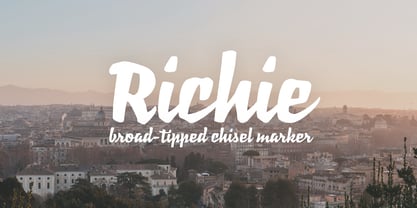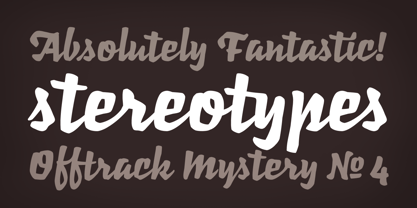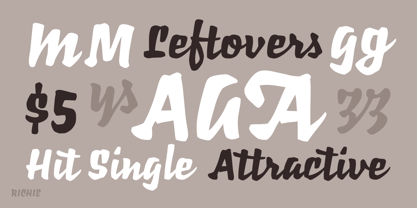Sélectionnez ce type de licence lorsque vous développez une application pour iOS, Android ou Windows Phone et que vous intégrez le fichier de fonte dans le code de votre application mobile.
Richie™
par Monotype


A propos de la famille Richie Police
Le caractère Richie™ est né d'une expérience de lettrage inspirée par le travail du créateur de caractères tchèque Oldrich Menhart (1897-1962). Les caractères de Menhart étaient principalement des conceptions de texte avec une forte influence calligraphique personnelle. Jim Ford, concepteur du studio Monotype, s'est demandé à quoi pourrait ressembler un caractère d'affichage de Menhart et a commencé à dessiner des caractères d'écriture audacieux avec un marqueur biseauté à pointe large. "C'était un exercice familier mais laborieux", explique Jim Ford. "J'ai essayé d'obtenir un caractère aléatoire authentique, mais contrôlé, qui servirait de base à une police de caractères". Ford a d'abord dessiné une grande série de caractères à l'aide du marqueur. Tous les dessins ont ensuite été soigneusement ajustés et scannés. Ford a ensuite composé une police de caractères à partir des meilleures versions des lettres, qu'il a ensuite affinées. Le résultat est une écriture robuste, quelque peu excentrique et ludique, construite sur une base évidente de dessin à la main. Dans un monde d'écritures lisses, le design de Richie est lourd, épais et rugueux. Sa sensation de fabrication à la main et son rythme vigoureux mettent la puissance du lettrage brut au pinceau entre les mains du typographe. L'OpenType® polices de Richie comprend des ligatures standard, contextuelles et discrétionnaires, ainsi que des alternatives contextuelles et stylistiques, des chiffres de style ancien, de doublure et supérieurs, ainsi qu'un grand nombre de swashs. Le nom "Richie" ? Il est né de l'idée de départ de Ford. Je me suis demandé à quoi cela ressemblerait si le "vieux Richie" avait conçu une face d'affichage lourde ou un script.
Concepteurs : Jim Ford
Éditeur : Monotype
Fonderie : Monotype
Maître d'ouvrage : Monotype
MyFonts débout : nul

À propos Monotype
La bibliothèque de Monotype est l'une des collections de caractères les plus vastes et les plus complètes au monde. Elle comprend des dessins originaux d'importance historique et une nouvelle gamme de caractères contemporains et à la mode : polices. La bibliothèque de Monotype comprend des milliers de classiques intemporels, des reprises artisanales et des dessins originaux provenant des créateurs de caractères et des fonderies les plus innovants de l'histoire. Cette bibliothèque distinctive et primée de polices offre aux marques et aux concepteurs une sélection large et fiable de caractères pour une typographie expressive à l'impression et à l'écran. La page Premium Foundry peut être consultée ici.
En savoir plus
Lire moins